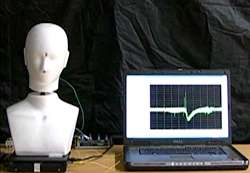August 26, 2010 report
Robot with frog egg smell sensor (w/ Video)

(PhysOrg.com) -- Researchers from the University of Tokyo have invented a novel means of improving a robot's sense of smell, by using inexpensive olfactory sensors containing frog eggs.
The researchers, Nobuo Misawaa, Hidefumi Mitsunob, Ryohei Kanzakic, and Shoji Takeuchi, used eggs from the African Clawed Frog (Xenopus laevis) to build their sensors. Eggs from this frog have been used in many laboratories to express olfactory receptors, and their protein expression mechanisms are well understood. This is the first time frog eggs have been used in a robot.
The immature eggs were harvested and then injected with DNA from fruit flies, silk moths and diamond back moths, which stimulated the eggs to produce the olfactory sensors of these insects. Takeuchi, a bioengineer at the University, said the eggs basically acted as a platform for the parts of the insect DNA that have been shown in the past to be responsible for detecting gases, odors, and pheromones.
The genetically modified eggs were placed between a pair of electrodes to form a detector, which measures the current created when the receptors on the egg bind with the odor molecules. The frog egg detectors are far more sensitive and accurate than other biological smell receptors that use the physical vibrations of quartz rods that vibrate when target odor molecules bind to them. These detectors tend to give false positives when other molecules with similar molecular weights to the target molecules bind to them.
The frog egg smell detectors were demonstrated in a robotic mannequin that shakes its head when it comes into contact with moth pheromones. It is capable of detecting solutions containing only a few parts per billion of the target molecule, and can distinguish between molecules with only slight differences such as -OH, -CHO and -C=O groups.
The aim of future research is to use frog eggs to detect gases such as carbon dioxide. Takeuchi explained that the mosquito can detect people from the carbon dioxide they breathe out. This means the mosquito must have carbon dioxide receptors, and so if DNA is extracted from the mosquito and used to genetically modify the frog eggs, the eggs will also be able to detect the gas.
Takeuchi said aother possible future application would be to create detectors for the ketone odor produced by people with diabetes or for aldehydes or other allergens in foods.
The paper was published in the Proceedings of the National Academy of Sciences.
More information: Nobuo Misawa et al.: Highly sensitive and selective odorant sensor using living cells expressing insect olfactory receptors, Proceedings of the National Academy of Sciences, Published online before print August 23, 2010, doi:10.1073/pnas.1004334107
© 2010 PhysOrg.com

















